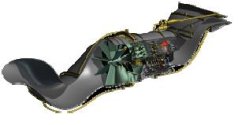You are using an out of date browser. It may not display this or other websites correctly.
You should upgrade or use an alternative browser.
You should upgrade or use an alternative browser.
Chengdu next gen combat aircraft (?J-36) thread
- Thread starter Blitzo
- Start date
I have noticed that the exhausts are not ducted and I wonder whether it will cause an increase in radar return signature. The following is a diagram of the ADVENT engine peogram of the USAF, notice how the exhaust is ducted (as well as the inlet) to achieve a minimum amount of rear RCS. Can the J36 also adopt such a design while still using the WS15 interim engine without losing too much thrust?A bit more artwork of the J-36 fightercruiser
View attachment 143638



I hope you realized now those are artworks…I have noticed that the exhausts are not ducted and I wonder whether it will cause an increase in radar return signature. The following is a diagram of the ADVENT engine peogram of the USAF, notice how the exhaust is ducted (as well as the inlet) to achieve a minimum amount of rear RCS. Can the J36 also adopt such a design while still using the WS15 interim engine without losing too much thrust?
View attachment 143659View attachment 143660View attachment 143661
Of course, clearly so.View attachment 143663
With the photo of the rear showing its YF23-ish nozzles it is almost without doubt the exhaust is not ducted.
You see the details inside the nozzle from like 4 black pixels?View attachment 143663
With the photo of the rear showing its YF23-ish nozzles it is almost without doubt the exhaust is not ducted.
I don't believe this has been shared before.

Video of said photo:
The chief designer's paper certainly noted the S-bend nozzle and the three-stream flow of the adaptive engine. But, "For non-afterburning subsonic stealth aircraft such as the B-2, the S-bend nozzle has been used; however, the application of the S-bend nozzle in the afterburning engine still faces more complex design issues such as local high temperature areas, performance degradation caused by uneven flow, and fluid-structure coupling under complex combined loads."View attachment 143663
With the photo of the rear showing its YF23-ish nozzles it is almost without doubt the exhaust is not ducted.
This thing either requires a completely new engine design or requires the modification of the existing engine. Who dare to use a new engine on the first flight of a new aircraft? The risk is so high.
has there been further test flights? it seems odd that it just flew once and then disappeared.

